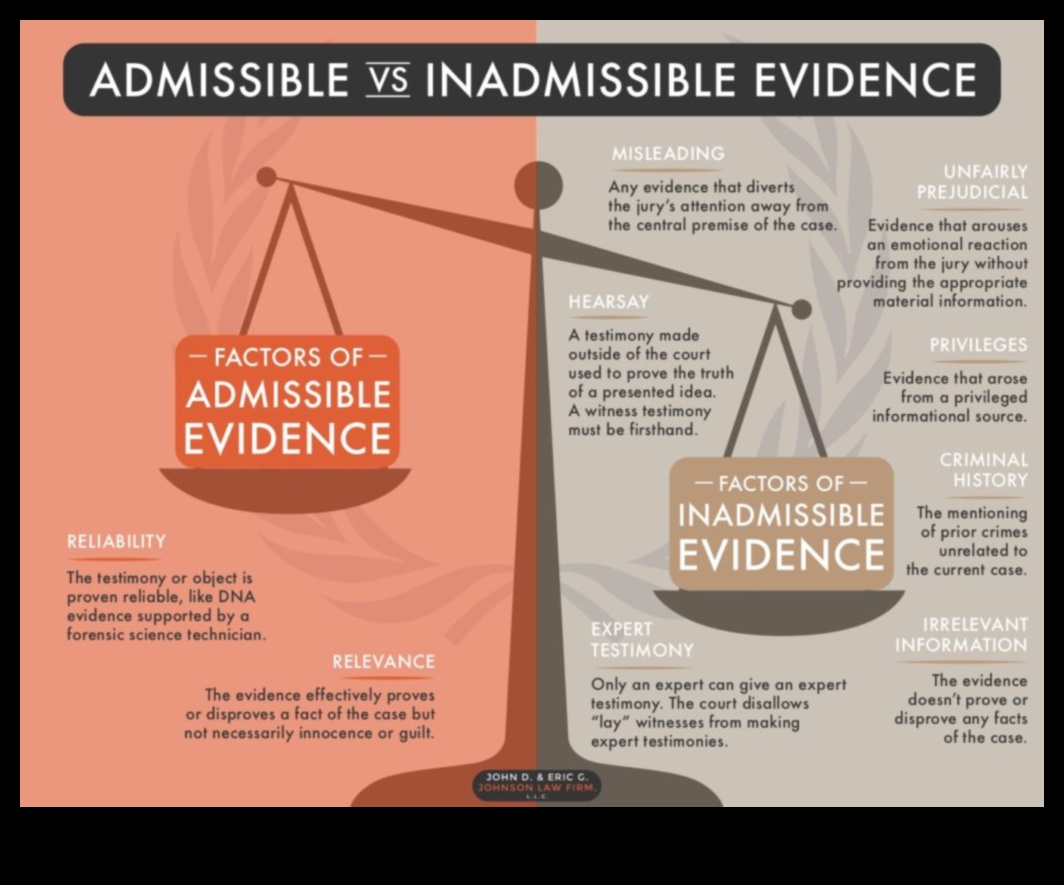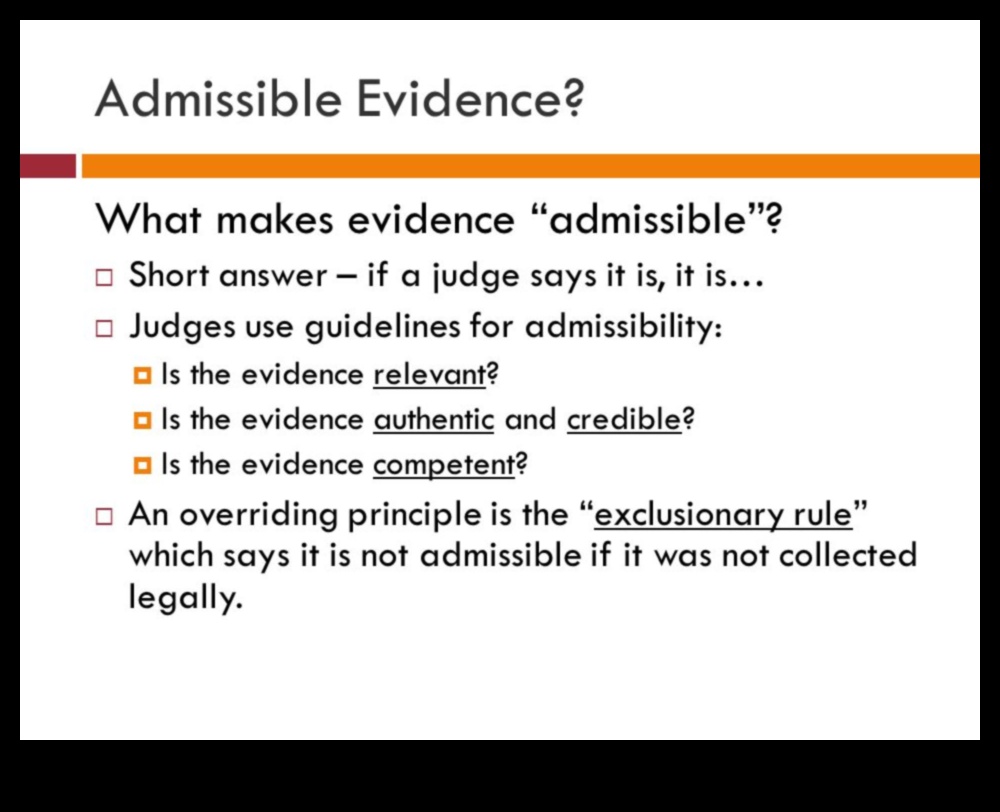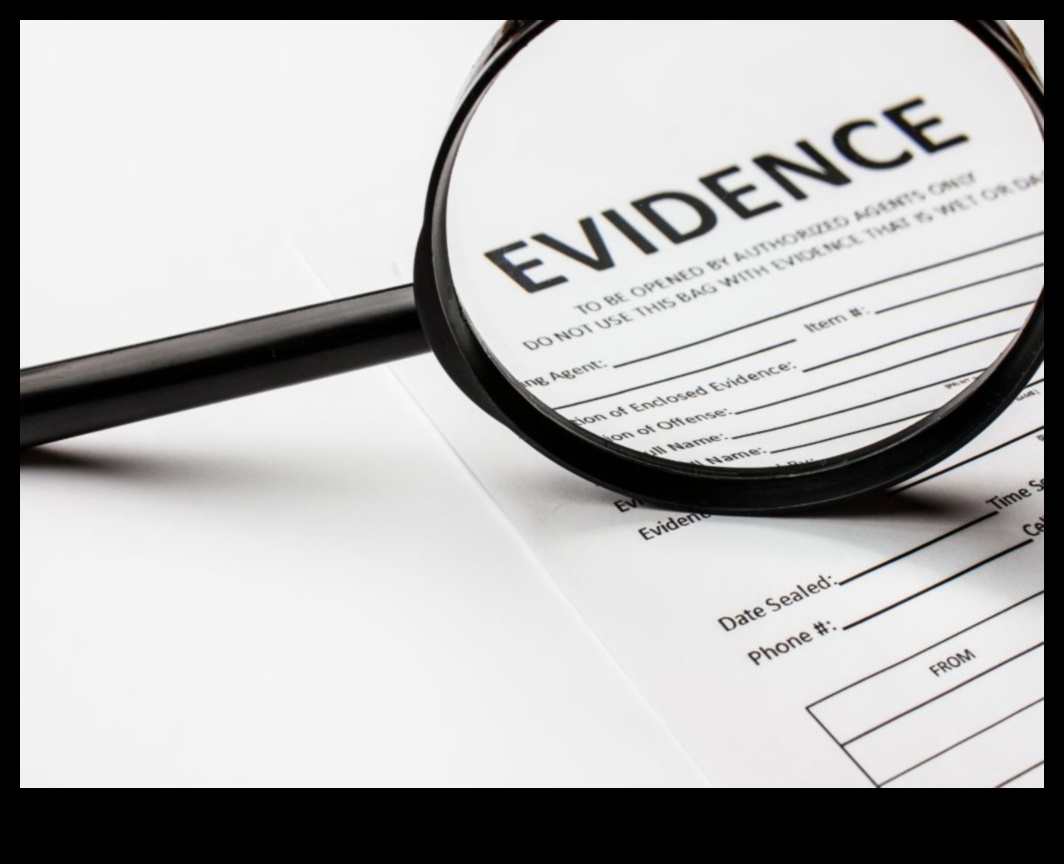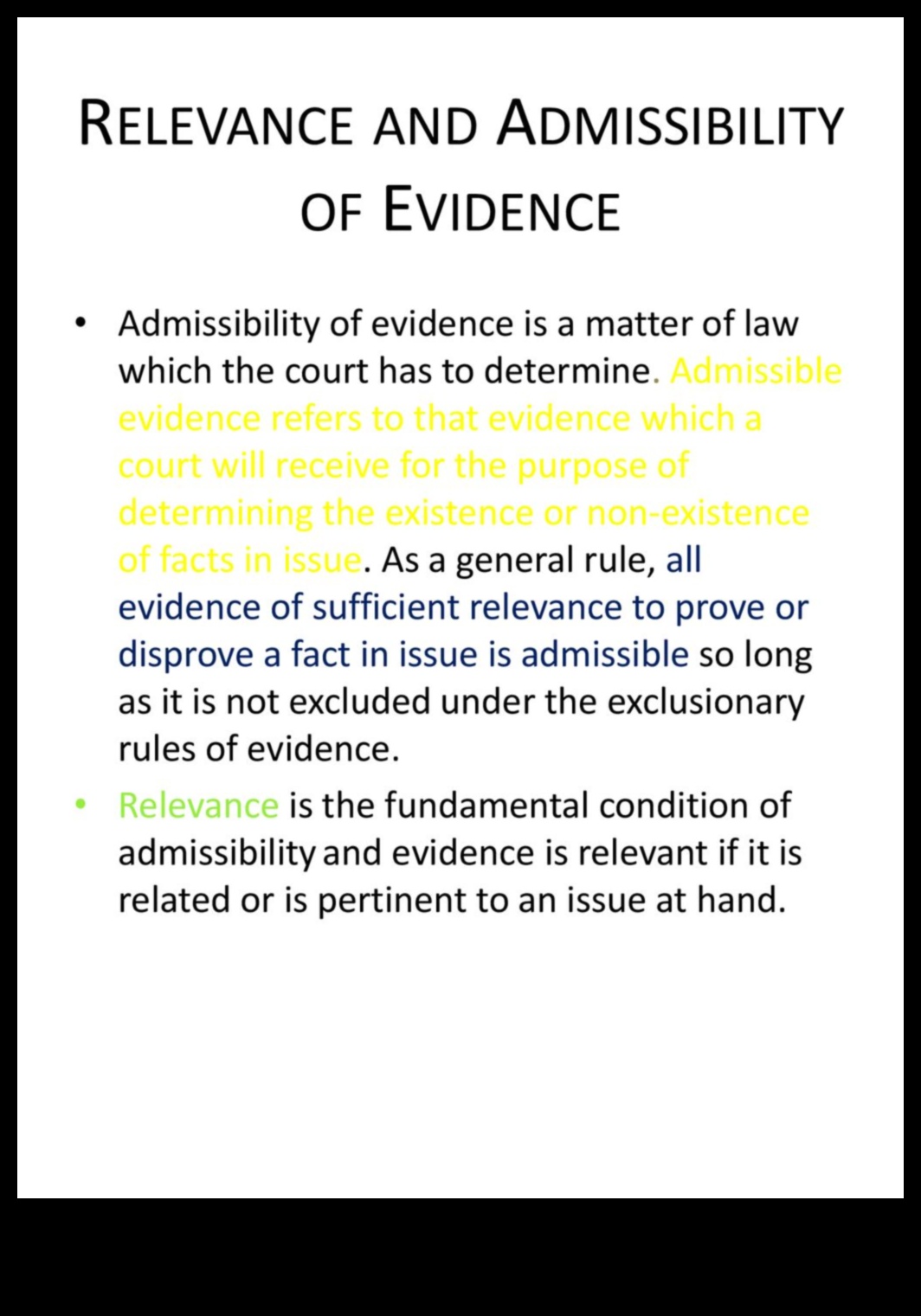
What is admissible evidence?
Admissible evidence is evidence that is legally allowed to be presented in a court of law. In order for evidence to be admissible, it must meet certain criteria, such as being relevant to the case at hand and being obtained legally.

Types of admissible evidence
There are many different types of admissible evidence, including:
- Testimonial evidence: This is evidence that is presented by witnesses who testify in court.
- Documentary evidence: This is evidence that is presented in the form of documents, such as contracts, letters, and emails.
- Physical evidence: This is evidence that is presented in the form of objects, such as weapons, drugs, and fingerprints.
- Expert testimony: This is evidence that is presented by experts who have specialized knowledge in a particular field.
How is admissible evidence obtained?
Admissible evidence is obtained through a variety of means, including:
- Witness testimony: Witnesses are called to testify in court and provide their firsthand accounts of events.
- Documentary evidence: Documents are obtained through subpoenas or other legal means.
- Physical evidence: Physical evidence is collected at the scene of a crime or other incident.
- Expert testimony: Experts are called to testify in court and provide their opinions on matters that are outside the knowledge of the average juror.
The importance of admissible evidence in the legal system
Admissible evidence is essential to the legal system because it allows jurors to make informed decisions about the guilt or innocence of a defendant. Without admissible evidence, jurors would not be able to evaluate the facts of a case and reach a verdict.
Challenges to the admissibility of evidence
There are a number of challenges that can be raised to the admissibility of evidence, such as:
- Relevance: Evidence that is not relevant to the case at hand may be excluded from trial.
- Hearsay: Hearsay is evidence that is not based on the personal knowledge of the witness and is therefore inadmissible.
- Privilege: Evidence that is protected by a privilege, such as the attorney-client privilege, may be excluded from trial.
How to preserve the admissibility of evidence
There are a number of things that can be done to preserve the admissibility of evidence, such as:
- Obtain evidence legally.
- Document the chain of custody of evidence.
- Mark evidence for identification.
- Store evidence properly.
The judge is responsible for determining whether or not evidence is admissible in a court of law. The judge will consider a number of factors when making this decision, such as the relevance of the evidence, the reliability of the evidence, and the potential for the evidence to prejudice the jury.
The jury is not responsible for determining whether or not evidence is admissible. The jury’s only role is to decide whether or not the defendant is guilty based on the evidence that is presented in court.
Admissible evidence is essential to the legal system because it allows jurors to make informed decisions about the guilt or innocence of a defendant. There are a number of challenges that can be raised to the admissibility of evidence, but there are also a number of things that can be done to preserve the admissibility of evidence.
- What is the difference between admissible evidence and relevant evidence?
- What is the difference between hearsay and non-hearsay evidence?
- What is the attorney-client privilege?
- How can I preserve the admissibility of evidence?
| Topic | Answer |
|---|---|
| What is admissible evidence? | Admissible evidence is evidence that is relevant and material to the case at hand, and is also reliable and trustworthy. |
| Types of admissible evidence | There are many different types of admissible evidence, including: |
| How is admissible evidence obtained? | Admissible evidence can be obtained through a variety of means, including: |
| The importance of admissible evidence in the legal system | Admissible evidence is essential to the fair and just administration of justice. |
II. Types of admissible evidence
There are many different types of admissible evidence that can be used in a court of law. Some of the most common types of evidence include:
- Testimonial evidence
- Documentary evidence
- Physical evidence
- Expert testimony
- Circumstantial evidence
Each type of evidence has its own unique strengths and weaknesses, and the admissibility of evidence will depend on the specific facts of the case.
II. Types of admissible evidence
There are many different types of evidence that can be admissible in court, including:
- Testimonial evidence
- Documentary evidence
- Real evidence
- Expert testimony
- Circumstantial evidence
Each type of evidence has its own unique strengths and weaknesses, and the admissibility of each type of evidence is determined by the rules of evidence.

II. Types of admissible evidence
There are many different types of evidence that can be admitted in court, including:
- Testimonial evidence
- Documentary evidence
- Real evidence
- Expert testimony
- Physical evidence
Each type of evidence has its own unique rules and requirements for admissibility. For example, testimonial evidence must be given by a witness who can testify under oath, while documentary evidence must be original and authentic.
The admissibility of evidence is determined by the judge, who will weigh the probative value of the evidence against its prejudicial effect. The judge will also consider the relevance of the evidence, its reliability, and its authenticity.
In order to be admissible, evidence must be relevant to the case at hand. This means that it must have a bearing on the issue that is being decided by the jury. The evidence must also be reliable, meaning that it is trustworthy and accurate. Finally, the evidence must be authentic, meaning that it is genuine and not a forgery.
If the judge finds that the evidence is admissible, it will be presented to the jury for their consideration. The jury will then decide whether the evidence is sufficient to prove the defendant’s guilt beyond a reasonable doubt.

V. Challenges to the admissibility of evidence
There are a number of challenges that can be raised to the admissibility of evidence in a court of law. These challenges can be based on a variety of grounds, including:
- Relevance
- Materiality
- Hearsay
- Privilege
- Unfair prejudice
- Collateral estoppel
- Other grounds
Each of these challenges has its own set of rules and requirements, and the judge will need to determine whether the evidence is admissible based on the specific facts of the case.
If the judge finds that the evidence is admissible, it will be allowed to be presented to the jury. However, if the judge finds that the evidence is inadmissible, it will not be allowed to be presented and the jury will not be able to consider it in their deliberations.
It is important to note that the rules of evidence are designed to ensure that only relevant and reliable evidence is admitted into court. This is necessary in order to protect the rights of the accused and to ensure that a fair trial is held.
VI. How to preserve the admissibility of evidence
There are a number of things that can be done to preserve the admissibility of evidence. These include:
- Making sure that the evidence is properly collected and preserved.
- Producing the evidence in a timely manner.
- Making sure that the evidence is relevant and material to the case.
- Making sure that the evidence is not hearsay.
- Making sure that the evidence is not unduly prejudicial.
By following these steps, you can help to ensure that your evidence will be admissible in court.
The role of the judge in determining admissibility
The judge plays a central role in determining the admissibility of evidence. In order to make a determination on admissibility, the judge must consider a number of factors, including:
- The relevance of the evidence to the case
- The probative value of the evidence
- The prejudicial effect of the evidence
- The availability of other, more reliable evidence
The judge must also balance the interests of the parties in the case, and ensure that the admission of the evidence will not violate any constitutional rights.
If the judge finds that the evidence is admissible, it will be allowed to be presented to the jury. If the judge finds that the evidence is inadmissible, it will not be allowed to be presented to the jury.
The judge’s decision on admissibility is final, and cannot be appealed.
The role of the jury in determining admissibility
The jury plays a vital role in determining the admissibility of evidence in a trial. The jury must decide whether the evidence is relevant and reliable, and whether it is more probative than prejudicial. The jury’s decision on the admissibility of evidence can have a significant impact on the outcome of the trial.
There are a number of factors that the jury may consider when determining the admissibility of evidence. These factors include:
- The relevance of the evidence to the case
- The reliability of the evidence
- The probative value of the evidence
- The prejudicial effect of the evidence
The jury must weigh these factors carefully in order to make a decision on the admissibility of evidence. If the jury finds that the evidence is relevant, reliable, and more probative than prejudicial, then it will be admitted into evidence. If the jury finds that the evidence is not relevant, reliable, or more probative than prejudicial, then it will be excluded from evidence.
The jury’s decision on the admissibility of evidence is a critical part of the trial process. The jury’s decision can have a significant impact on the outcome of the trial, and it is important that the jury carefully consider all of the factors before making a decision.
IX. Conclusion
Admissible evidence is essential to the fair and accurate administration of justice. It is the foundation upon which verdicts are reached and sentences are imposed. By ensuring that only relevant and reliable evidence is presented in court, the law protects the rights of both parties to a trial and helps to ensure that the verdict reached is just.
The rules of evidence are complex and constantly evolving. As new technologies emerge, the courts must decide how to apply the rules to these new forms of evidence. This can be a difficult task, but it is essential to ensure that the law keeps pace with the changing world.
By understanding the rules of evidence, lawyers can help their clients to present their cases in the most effective way possible. They can also help to protect their clients’ rights by ensuring that only admissible evidence is presented at trial.
Admissible evidence is a critical part of the legal system. It is the foundation upon which verdicts are reached and sentences are imposed. By ensuring that only relevant and reliable evidence is presented in court, the law protects the rights of both parties to a trial and helps to ensure that the verdict reached is just.
X. FAQ
Q: What is the difference between admissible and inadmissible evidence?
A: Admissible evidence is evidence that is allowed to be presented in a court of law, while inadmissible evidence is evidence that is not allowed to be presented.
Q: What are the criteria for evidence to be considered admissible?
A: The criteria for evidence to be considered admissible vary depending on the jurisdiction, but generally include the following:
- Relevance
- Materiality
- Probative value
- Legality
- Sufficiency
Q: What are the challenges to the admissibility of evidence?
A: There are a number of challenges to the admissibility of evidence, including:
- Hearsay
- Privilege
- Unreliability
- Other